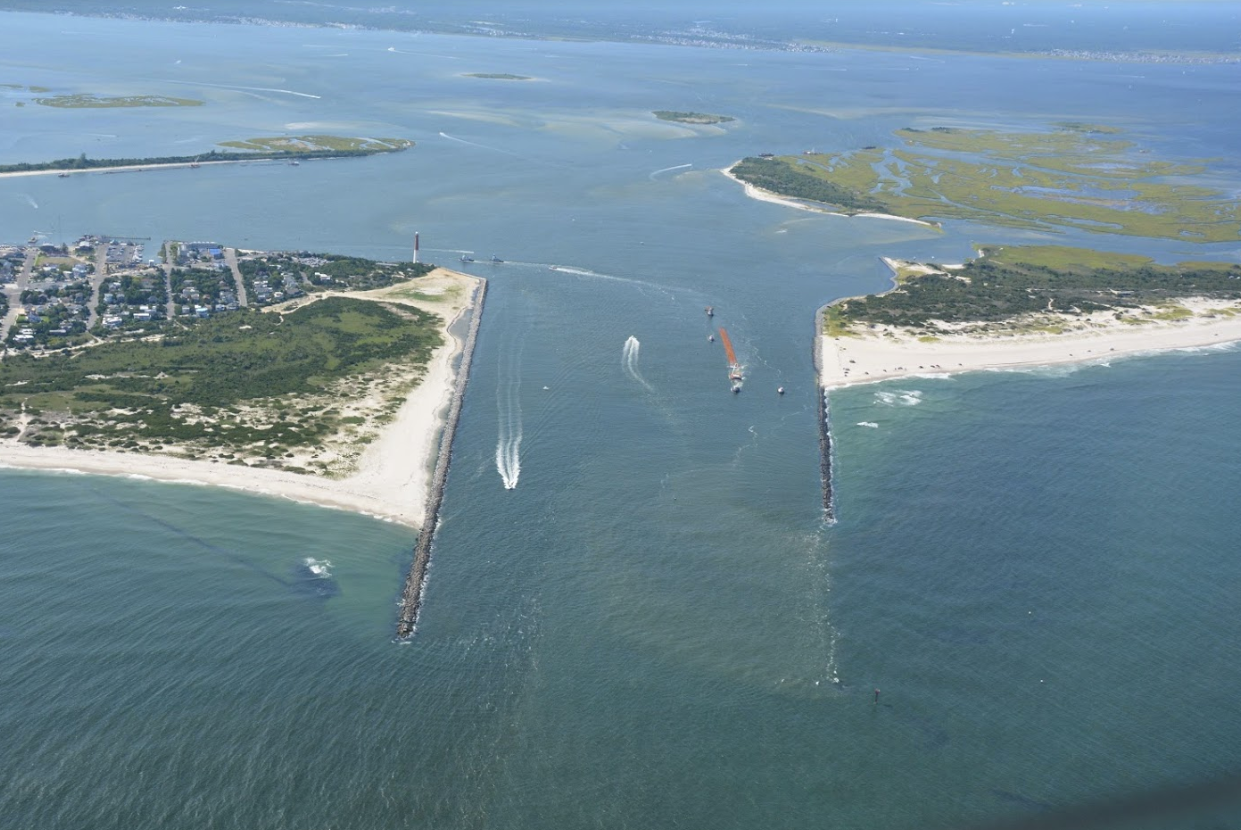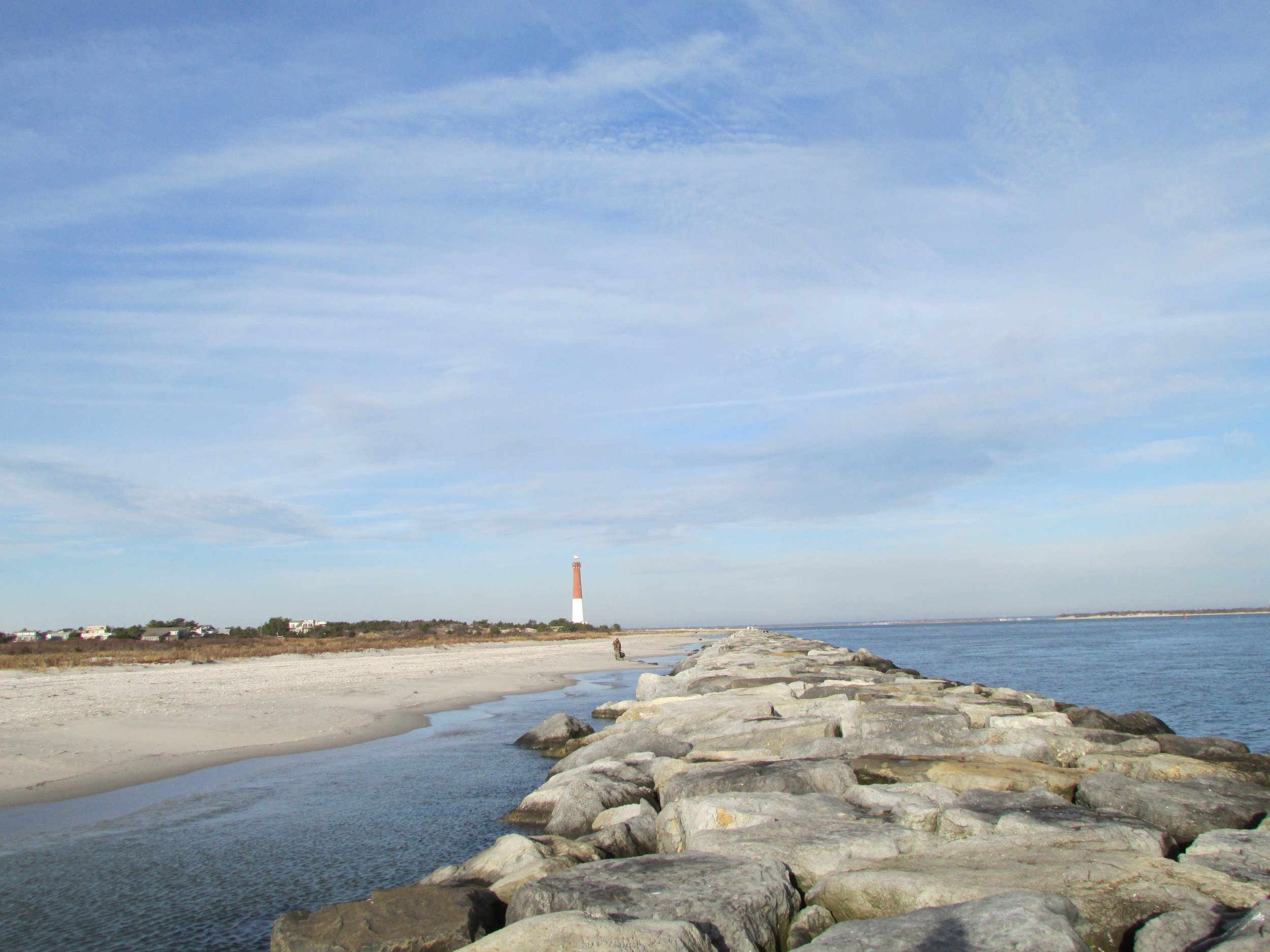Barnegat Inlet Study
Did you know…
Barnegat Inlet is a natural opening along the Jersey Shore that connects the Atlantic Ocean with the Barnegat Bay watershed region in Ocean County, New Jersey. It separates Island Beach State Park and the Barnegat Peninsula from Long Beach Island.
The historic Barnegat Lighthouse sits at the northern end of Long Beach Island along the inlet.
The Harlequin Duck (Histrionicus histrionicus) is a common winter visitor to the Barnegat Inlet. This small sea duck prefers a rocky coast and foraging among smashing waves for crustaceans such as crabs, amphipods, and barnacles; mussels and snails. The rock jetty and swift currents of the Barnegat Inlet make this an ideal winter retreat for Harlequin ducks along the Jersey Shore.
The continued threat of storms such as the Ash Wednesday Storm of 1962, reinforced concerns about the stability of the shoreline along the inlet. The construction of the existing jetty in the 1990s added a significant amount of land to the town of Barnegat Light, much of which was designated as parkland and now includes a bird sanctuary. The jetty has provided stabilization to the shoreline along the inlet, but requires frequent dredging.
The Barnegat Inlet has a long reputation as being a dangerous waterway for boating. In 1609, the area surrounding Barnegat Inlet was described by Henry Hudson as "...a great lake of water, as we could judge it to be ... The mouth of the lake hath many shoals, and the sea breaketh on them as it is cast out of the mouth of it." Over the past several decades, the inlet has been somewhat tamed with dredging and jetties and is in constant use by one of the largest commercial fishing fleets on the East Coast centered in Viking Village. But the inlet can still be treacherous today. Extensive shoals on either side of the inlet can cause some boats every year to get damaged on the jetty or sink from hitting a sandbar. For example, in March 2022, an 80-year-old man was rescued by the Coast Guard after his boat ran aground near Barnegat Inlet on March 7.
History of the Barnegat Inlet
In 1609, Henry Hudson sailed along the coast of present-day New Jersey. When his ship, De Halve Maen (The Half Moon), came upon the inlet, he named it “Barende-gat,” a Dutch word meaning an inlet with breakers, or a heavy sea wave that breaks into white foam on a shoal or sandbar. This name was replaced by “Barndegat” by early European mapmakers. The word later evolved into the present day spelling of Barnegat.
Due to extensive shoals and numerous shipwrecks, the federal government funded a congressional appropriation of $6,000 in 1834 to construct a lighthouse at a location some 300 feet south of the inlet. In 1856, Congress budgeted $60,000 to replace the original lighthouse with a first-order light at the Barnegat Inlet. The current Barnegat Lighthouse was in use from 1857 until just after World War II. Today the lighthouse is managed by NJ State Parks. The State of New Jersey took possession of the lighthouse and surrounding area and turned it into a state park in 1957.
The Barnegat Inlet was developed by the Army Corps of Engineers between 1937 - 1940. BUT the Supplemental Appropriation Act of 1985 contained language stating that the project had not worked as planned and, in fact, created a hazard to navigation. As a result, the federal government approved modifications that were constructed in 1991. Improvements included: a new south jetty 4,270 feet in length along an alignment generally parallel to the existing north jetty, a navigation channel 300 feet wide to a depth of 10 feet below mean low water from the outer bar in the Atlantic Ocean to the north end of the existing sand dike in Barnegat Bay. Today, federal funds are routinely used for channel surveys and maintenance dredging.
MORE INFORMATION
Shellfishing & Fishing at Barnegat Inlet
Shellfish (hard clams, oysters, and scallops) are an important natural resource and economic driver for Barnegat Bay. The general public is allowed to harvest soft-bodied gastropods by hand or by using a clamming rake, BUT a Recreational Shellfish Harvesting Permit is required to take your clams home! Review current regulations and apply for a permit here!
With fast currents and deep pockets of water, the inlet offers places for many species of fish to rest and forage. Fishing can be productive throughout the course of the year. Striped bass, fluke, bluefish, and tog (blackfish) are among the most sought after game fish in the inlet. Crabbing is also a notable recreational activity in the bay, especially west of the lighthouse.
Biological Surveys of Barnegat Inlet:
2023 aerial profile of the Barnegat Inlet
Topo Map of Barnegat Inlet, April 1898.





